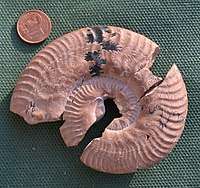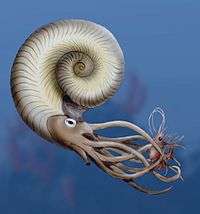Krempachy Marl Formation
The Krempachy Marl Formation is a geological formation in Poland and Slovakia, dating to about 179 million years ago, and covering the middle Toarcian stage of the Jurassic Period.[1] It is among the most important formations of the Toarcian boundary on the Carpathian realm, being the regional equivalent of the Posidonia Shale.[2]
| Krempachy Marl Formation Stratigraphic range: Middle Toarcian ~179 Ma | |
|---|---|
 Przełom Białki, near where strata of the formation appear | |
| Type | Geological formation |
| Unit of | Pieniny Klippen Belt |
| Underlies | Podzamcze Limestone, Skrzypny & Harcygrund Shale |
| Overlies | Allgäu Formation & Orava Unit |
| Thickness | 10–30 m (33–98 ft) |
| Lithology | |
| Primary | Marl & limestone |
| Other | Lithified limestone |
| Location | |
| Region | Nowy Targ County-Prešov Region, West Carpathians |
| Country | |
| Type section | |
| Named for | Krempachy, a village in southern Poland |
| Named by | Birkenmajer |
| Year defined | 1977 |
The formation has been considered as following the model of the Fleckenmergel Marl, without macroscopic paleodepths implicated on the processes. The facies of the formation developed on the Pieniny Klippen Basin, being influenced by the widespread of the Late Liassic Tethys.[2] The formation was a succession of nearshore to epicontinental deposits, with several of the only Toarcian terrestrial deposits know from the Bohemian Massif. It also gives one of the few limited insights into paleoceanographic changes that took place in this area during this key time interval.[3]
Geology

The Pieniny Klippen Belt represents an axial tectonic zone on the West Carpathians, with a narrow structure, that extends a several hundred kilometers long structural zone belonging to the Carpathian sector of the Alpide belt, and separates the Outher Carpathian and the Central Carpathian.[2][4] While the Pliensbachian-Toarcian boundary is nearly unknown on the Belt, the Toarcian to Bajocian succession is present on various points.[2] The belt is a Laramian Front inside the Central Carpathian Orogenic Wedge, that had a re-folded along with an strong compressed process during the Alpine thrusting of the Outer Carpathians in the Neogene.[4] The belt has a series of lithofacies patterns that recover from the Middle Jurassic to the Lower Cretaceous paleogeographical changes on the east Bohemian Massif margin, and reflects a paleobathymetric gradient change, that was developed around the Czorsztyn Swell de to a crustal block of Oravicum,[5] correlated to the contemporaneous Briançonnais.[6] The Toarcian basin basin was located to the north of Oravicum, being on the NE of the North European Shelf.[4] It was an areas that suffered from Middle Jurassic that woul have ended forming the Magura Basin.[4] After that, sedimentary infill was translated northward to the nearshore platforms, and then formed nappe structures and flysch mélange.[7] The view and reconstruction of the sedimentary basins on the Toarcian realm is very complicated, since they lost their original geometry due to tectonic works and deformations on the Noegene, abundant allochtonous material and several hiatus on the strata.[4]
Sedimentology
The strata of the formation is composed by grey-blue marl & limestones. The formation overlies Sinemurian to Pliensbachian deposits of the Orava Unit, where there is disposed a southwest bedding dipping. The lowermost part of the strata recovers spotted limestone beds & alternations of dark Marls that are equivalent to the uppermost Allgäu Formation.[8] Over the marls there is a series of dark shales that had intercalated siltstones, that mark the start of the main Krempachy Marl Formation. The marls of the main formation strata are covered on Ammonite fragments, intercalated with Dinoflagellates.[9] There is a condensation of the Lower-Middle Toarcian deposits throughout the Western Carpathians. As that, in the Pieniny Klippen Belt, sections like the Tenuicostatum and Serpentinum zones of the early Toarcian are or completely missing or strongly condensed.[10] Altroght sections such as Zázrivá A provide the first record of the T-OAE from all Western Carpathians.[9] Zázrivá A has an expressure of 36 m, oriented to the Southwest.[4]
Lithology
The Krempachy Marl is rich in black shales in its lowermost parts, that are locally rich in macrofauna, including ammonites, soft bodied cephalopods,[9] bivalves, crustaceans and fish remains.[4] Manganese mineralization is also common in the oldest part, something shared with most of the coeval Alpine Tethys successions.[11] Due to that, there is a high concentration of Mn contents (6 to 10 wt%).[12] Typical Toarcian sections of the Orava Succession are represented by condensed red marls, marly limestones, and/or red nodular limestones, being locally rich in ammonites.[4]
Fossil content
Geochemical, palynological and mineralogical framboid data show that dysoxic to euxinic conditions occurred in an epicontinental basin located close to the Tethys open-ocean during the T-OAE, and continued after it.[4] Organic-rich sedimentation and anoxic conditions were clearly shorter-lived in the southern basins, where evidence for elevated organic carbon burial is generally restricted to the CIE.[4] There are results that indicate poor oxygenation, elevated carbon and sulfur burial developed in basins located very close to the open-ocean masses of the Tethys Ocean, similar to modern large euxinic basins.[4] The basin was located between Oravicum, with an initial area of ~100,000 square kilometers, and the NW-European shelf and has been associated with considerable amounts of sulfur and carbon during the T-OAE.[4] The presence of brown eood traces has been interpreted as reflecting the proximity of land areas, with fluvial run-off supplying fresh phytoclasts. Although most of the basin lacks unequivocal palynological evidence for brackish conditions, such as the freshwater green algae Botryococcus, being related to effects due to changes in oxygenation.[4]
Color key
|
Notes Uncertain or tentative taxa are in small text; |
Megaspores
| Genus | Species | Stratigraphic position | Material | Notes | Images |
|---|---|---|---|---|---|
| Inaperturopollenites[4] | Inaperturopollenites orbiculatus | Zázrivá | Multiple spores | Affinities with the Pinidae. Coniferales wood from medium to large plants, associated with nearshore environments. | |
Cephalophoda
| Genus | Species | Stratigraphic position | Material | Notes | Images |
|---|---|---|---|---|---|
| Teudopsis[9] | Teudopsis bunelii | Zázrivá | Various specimens | A Teudopseina squid | |
| Eleganticeras[9] |
|
Zázrivá | Multiple specimens | A hildoceratid ammonite. The most abundant ammonite in the formation, that includes specimens from 30 to 45 cm. | |
| Hildaites[9] | Hildaites ex. gr. murleyi-levisoni | Zázrivá | Multiple specimens | A hildoceratid ammonite |  Hildaites specimen (from Italy) |
| Harpoceras[9] | Harpoceras ex. gr. falciferum | Zázrivá | Multiple specimens | A harpoceratin ammonite |  |
| Dumortieria[9] | Dumortieria striatulocostata | Zázrivá | Multiple specimens | A hildoceratid ammonite | |
See also
- List of fossiliferous stratigraphic units in Poland
- List of fossiliferous stratigraphic units in Slovakia
- Toarcian turnover
- Toarcian formations
- Marne di Monte Serrone, Italy
- Calcare di Sogno, Italy
- Sachrang Formation, Austria
- Saubach Formation, Austria
- Úrkút Manganese Ore Formation, Hungary
- Posidonia Shale, Lagerstätte in Germany
- Ciechocinek Formation, Germany and Poland
- Lava Formation, Lithuania
- Azilal Group, North Africa
- Whitby Mudstone, England
- Fernie Formation, Alberta and British Columbia
- Poker Chip Shale
- Whiteaves Formation, British Columbia
- Navajo Sandstone, Utah
- Los Molles Formation, Argentina
- Mawson Formation, Antarctica
- Kandreho Formation, Madagascar
- Kota Formation, India
- Cattamarra Coal Measures, Australia
References
- Birkenmajer, K. 1977. Jurassic and Cretaceous lithostratigraphic units of the Pieniny Klippen Belt, Carpathians, Poland. Studia Geologica Polonica 45: 1–158
- Tyszka, J. A. R. O. S. Ł. A. W. (2001). Microfossil assemblages as bathymetric indicators of the Toarcian/Aalenian “Fleckenmergel”-facies in the Carpathian Pieniny Klippen Belt. Geologica Carpathica, 52(3), 147-158.
- Gedl, P. (2008). Organic-walled dinoflagellate cyst stratigraphy of dark Middle Jurassic marine deposits of the Pieniny Klippen Belt, West Carpathians. Studia Geologica Polonica, 131, 7-227.
- Suan, G., Schöllhorn, I., Schlögl, J., Segit, T., Mattioli, E., Lécuyer, C., & Fourel, F. (2018). Euxinic conditions and high sulfur burial near the European shelf margin (Pieniny Klippen Belt, Slovakia) during the Toarcian oceanic anoxic event. Global and Planetary Change, 170, 246-259.
- S.M. Schmid, et al. The Alpine-Carpathian-Dinaridic orogenic system: correlation and evolution of tectonic units Swiss J. Geosci., 101 (1) (2008), pp. 139-183
- R. Trümpy A Possible Jurassic-Cretaceous Transform System in the Alps and the Carpathians J.S.P. Clark, B.C. Burchfiel, J. Suppe (Eds.), Processes in Continental Lithospheric Deformation, Geological Society of America (1988)
- E. Jurewicz The Šariš Transitional Zone, revealing interactions between Pieniny Klippen Belt, Outer Carpathians and European platform Swiss J. Geosci., 111 (1–2) (2018), pp. 245-267
- Gawlick, H.-J., S. Missoni, F. Schlagintweit, H. Suzuki, W. Frisch, L. Krystyn, J. Blau, and R. Lein. 2009. Jurassic tectonostratigraphy of the Austroalpine Domain. Journal of Alpine Geology 50: 1–152.
- Schlögl, J., Košt’ák, M., & Hyžný, M. (2012). First record of a gladius-bearing coleoid Teudopsis bollensis Voltz (Cephalopoda, Coleoidea) in the Toarcian of the Western Carpathians (Slovakia). Paläontologische Zeitschrift, 86(4), 367-375.
- A. Arabas, J. Schlögl, C. Meister Early Jurassic carbon and oxygen isotope records and seawater temperature variations: Insights from marine carbonate and belemnite rostra (Pieniny Klippen Belt, Carpathians) Palaeogeogr. Palaeoclimatol. Palaeoecol., 485 (Supplement C) (2017), pp. 119-135
- N. Sabatino, et al. Petrography and high-resolution geochemical records of lower Jurassic manganese-rich deposits from Monte Mangart, Julian Alps Palaeogeogr. Palaeoclimatol. Palaeoecol., 299 (1–2) (2011), pp. 97-109
- I. Rojkovič Manganese mineralization in Jurassic sequences Slovakia Geol. Carpathica (53) (2002), pp. 87-89